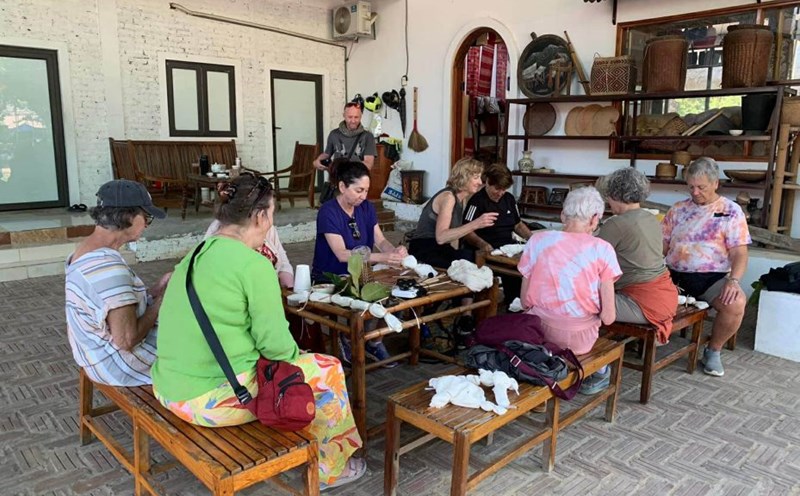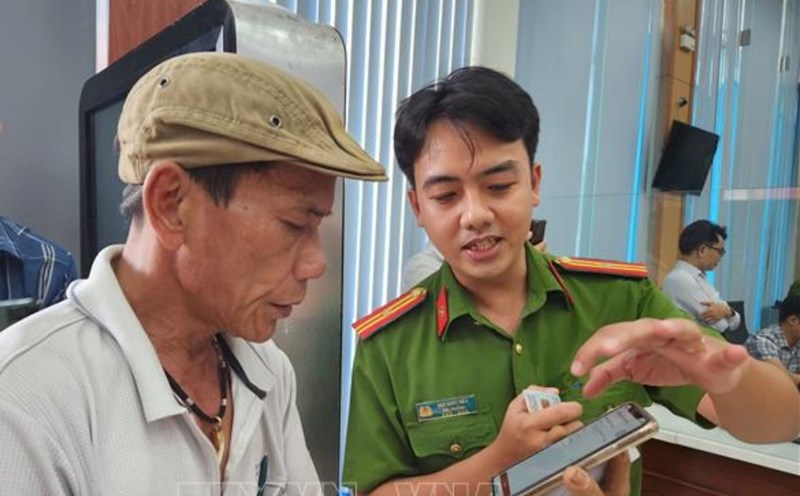The threads that connect into the soul of the nation
In the areas of Muong Bi, Vang, Thanh, Dong in Hoa Binh province (old) now Phu Tho province, mothers and grandmothers are still diligent in taking the floor. Under the sloped stilt roof, the sound of the wind breezes, the sound of the frame throbbing resounds like the breathing of the mountains and forests. Each needle, each pattern is created not only by skillful hands but also by memory and pride.
The folk culture researcher Tu Chi once wrote: They dont carve on wood, on stone, on metal... but they weave their aesthetic concept into womens robes! The dress stall here is like a statue, like a painting!.
According to Mr. Bui Van Nam - Specialist of the Heritage Management Department, Department of Culture, Sports and Tourism of Phu Tho province, the art of decorating patterns on the dress is not only an aesthetic element but also a "languageless annual report", reflecting the optimistic and biological world of the Muong people. There is sky, earth, mountains, rivers, flowers, leaves, wild animals, and even the dream of a crop, couples, and peace in Muong village.
The technique of decorating the dress on the traditional costumes of the Muong people in Hoa Binh (old) was born in conjunction with the operation and development of the ethnic group in history and present. Previously, in traditional society, the conditions for contact and exchange with other ethnic groups were limited, the Muong people had to be completely independent in materials, creating fabric and decorating costumes.
When historical conditions change, the concept of aesthetics, garments, learning environment, production techniques, and traditional costumes of the people also quickly develop, adding new factors to suit the new context.
Thereby, the costumes have recorded the mark of each historical period and through each period, the material and spiritual life of the people is recreated through the strong, diverse, unique and profound vibrations that the Muong people have conveyed through decorative art to the traditional costumes of their people.
In each Muong family today, each member (from children to the elderly) has one to two traditional costumes to wear on holidays and weddings. In the traditional wedding ceremony of the Muong people, brides still have to wear their traditional costumes.
A treasure trove of patterns and memories
The Muong dress trellises are divided into three parts: Top roasted, bottom roasted and high. The top is mainly formed by shakes such as: Crossed crab, star, cross, hook... The lower part is more sophisticated, recreating a lively world with dragons, phoenixes, birds, deer, spiders, captains, daffodils, clouds... Each shape is a message: Dragon is power, deer is gentleness, birds are freedom, sim flowers are peace, urban flowers are memories of the ancient village...
Ms. Bui Thi Mia - Deputy Director of the Traditional Brocade Weaving Cooperative of Dong Lai commune (now in Tan Lac commune, Phu Tho province) shared: "Not only need to be skillful but also have a heart. Each pattern is a message. We are not woven according to patterns, but according to emotions, according to memories".
Weaving techniques are also extremely elaborate. Some patterns need 40 - 50 bamboo sticks to pick up the fibers. Even a bend is wrong with the pattern, wrong with the soul of the dress.

To make a dress, the craftsman has to go through many meticulous stages such as tying fabric, picking patterns, weaving, roasting on top, roasting on bottom... Roasting on top is the world order, roasting on bottom is the natural world, the top is the color accents, all coordinate to create a visual symphony.
The patterns express sophistication, ingenuity and high aesthetic thinking, simulating the sun, animals, plants, conveying philosophies of life, beliefs, and social plight. Each dress is a "brocade book", preserving the memories, souls and identity of the Muong people.
In addition to material values suitable for the environment and living conditions, costumes also deeply express traditional cultural and social values with ethnic cultural characteristics. The decorative patterns of the dress also show the class origin in the ancient Muong society.
Women of the Lang - Dao class have the right to use a dress with elaborate patterns, decorated with phoenix, fairy bird, large disc flower..., while the common class is only allowed to use a dress to decorate with simple shakes, children, spiders, black frog, green fruit...
The images and decorative art on the costumes reflect part of the life of the Muong Hoa Binh people, reflecting their worldview, thinking, concepts and aspirations for life.
Concerns between traditional and modern banks
Like many other traditional crafts, the art of weaving and dressing is facing the risk of extinction. Industrial regalia are cheaper and more convenient. Young people are less likely to stick to the bullet and silk.
In Dong Lai commune, Phu Tho province, the girls are excitedly watching the hands of the grandmothers and mothers teaching how to hook patterns on Muong robes. Ms. Duong Thi Bin - Director of Luc Nghiep Thanh Traditional Brocade Weaving Cooperative, now in Dai Dong commune, the new Phu Tho province, said: "Every summer, female students participate in "free vocational training classes" of mothers and mothers in the cooperative.
The learning space is the stilt house, the desks are the frame, the textbooks are the dresses of mothers and mothers. The small, awkward hands are at first, and then gradually become proficient in each weaving step.
Mr. Tran Cong Lam - Chairman of the People's Committee of Dai Dong Commune, Phu Tho Province said: "Weaving is a part of the cultural roots of the ancient Muong Vang region. In recent times, the commune has implemented many solutions to help people preserve and develop traditional crafts".
The art of creating patterns on the ears of the Muong people is recognized as a National Intangible Cultural Heritage - a worthy recognition for the journey of silent preservation of many generations.
The locality has also had many solutions to preserve and develop traditional occupations such as: Directing localities to annually restore and organize traditional festivals, contests "Beautiful people perform in Muong ethnic costumes" and cultural activities, art performances...
The government encourages tourism service businesses and tourist attractions to use traditional costumes of ethnic groups in general and costumes of the Muong ethnic group in particular. Many communes also link conservation with community tourism, turning storks into unique cultural products.











